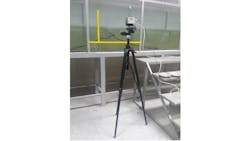Researchers Measure Breakwater Wave Dissipation Using High-Speed Cameras
Unterschleißheim, Germany—Floating breakwaters are lightweight, low cost pontoon-type structures used to minimize coastal erosion, intercept the movement of sediments, and help isolate vessels from marine hazards by dissipating wave energy. Floating breakwaters are increasingly seen as an alternative to fixed concrete breakwaters that are both expensive and time-consuming to construct. Concrete breakwaters also require a high-resistance seabed, unlike a floating breakwater that only needs a substrate for mooring lines.
Related: High-Speed Vision System Used for Human-Robot Collaborative System
Researchers at the Islamic Azad University in Tehran, Iran, conducted a review of floating breakwater performance, executing a series of tests on two different cubic shapes—a simple pontoon and a stepped slope pontoon—featuring unique transfer coefficients. Each was subjected to various sea conditions, with the performance evaluated and calculated. Finally, after analyzing and comparing the obtained transmission coefficients, researchers determined the best breakwater in terms of performance in the developed laboratory conditions.
In each experiment, the two floating breakwaters were subjected against 250 regular and irregular waves, events that were captured with a Mikrotron MotionBlitz Cube high-speed camera at 100 frames per second (fps). MATLAB and AutoCAD software processed the resulting images. Each test on the different floating breakwaters ran 44 seconds using a hinged wave maker able to produce different wave heights, wave lengths, time periods and speeds within the lab's wave channel. Individual frames from the video were analyzed to determine the wave's transmission through the breakwater, specifically its height before and after impact.
Since its resolution and speed can be variably adjusted, the Mikrotron MotionBLITZ EoSens camera proved to be flexible and met the researcher's requirements for test purposes. Owing to the built-in circular buffer, the camera can record experimental setups up to 13 seconds at full resolution without any connection to a notebook or PC. Frame rates up to 523 fps ensure consistent control of fast processes, even in poor and changing lighting conditions.
After analyzing and comparing the obtained transmission coefficients, the best breakwater design in the developed conditions was determined. Based on test data analysis, in shorter duration waves and lower drafts, simple pontoons were adequate protection, while in longer duration wave periods and deeper drafts, a stepped pontoon breakwater was required.
For more information visit www.mikrotron.de.
1. Samaei, S., Asadian Ghahferokhi, M., Azarsinai, F. (2022). 'Experimental study of two types of simple and step floating pontoon breakwater in regular waves', International Journal of Marine Science and Environment, 6(1), pp. 8-16.
